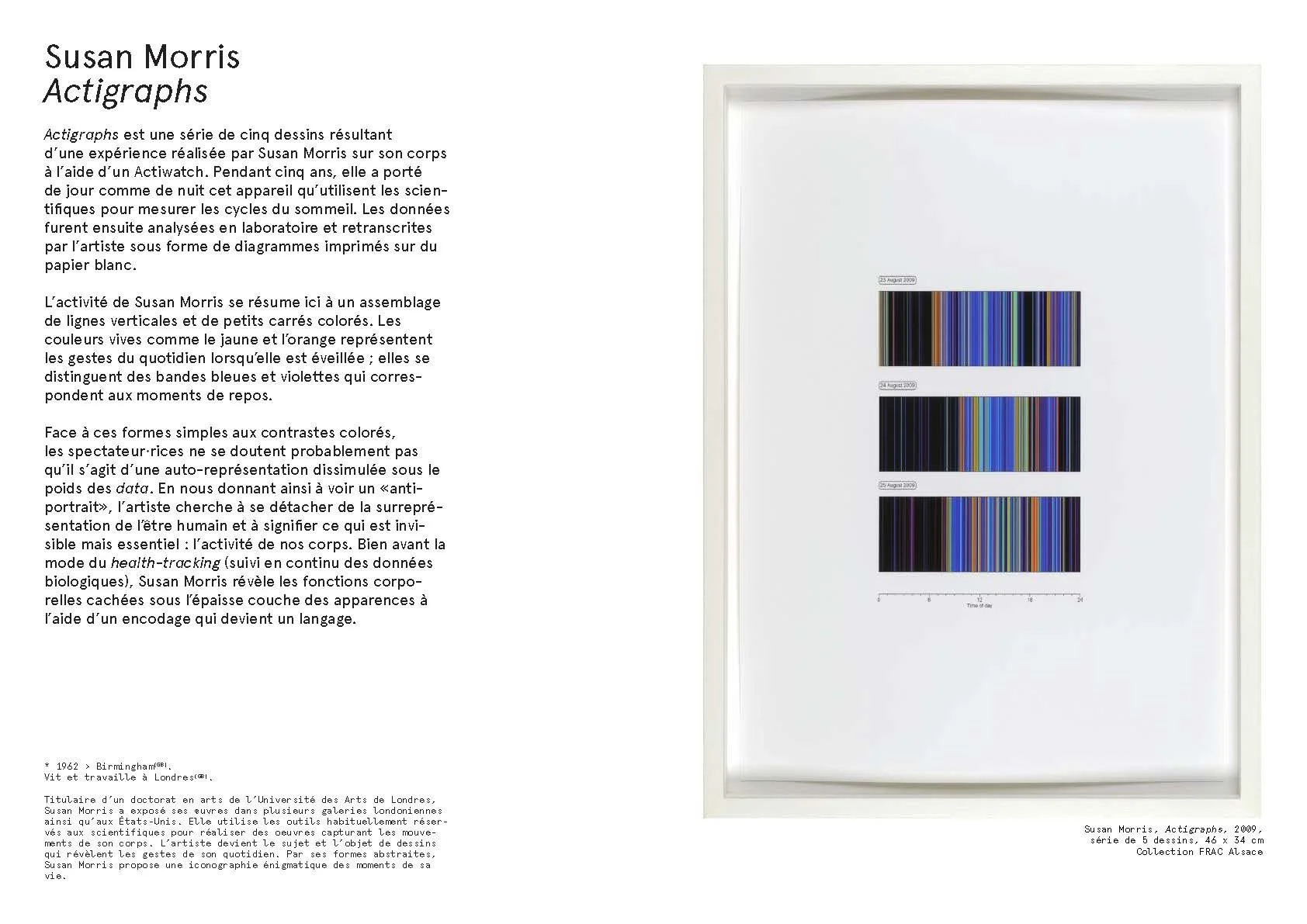NOUER LE RESTE: Work selected from FRAC du Grand Est collection
Exposition au Centre d'art
CEAAC, Strasbourg
11th July - 26th September, 2021
Julien Discrit, Dora Garcia, Jean-Marie Krauth, Georges Lappas, Barbara et Michael Leisgen, Marianne Mispelaëre, Susan Morris, Ed Pien, Younès Rahmoun, Jean-Christophe Roelens, Emmanuel Saulnier, Mükerrem Tuncay, Cy Twombly, Lois Weinberger
Five pieces from the Actigraph series, 2009. Recordings of the artist’s activity and rest patterns made by wearing an Actiwatch, a scientific-medical device used by Chronobiologists to track disturbances in sleep. PHOTO: R.Görgen.
Building connections between humans, creating alliances with flora and fauna, sowing seeds of ideas to learn how to live on a damaged planet—these are the ambitions of the exhibition "Knotting the Rest," presented from June 11 to September 26, 2021, at the CEAAC.
Emerging from a fertile ground of fiction and "situated knowledge" by authors such as Donna Haraway, Vinciane Despret, Anna Tsing, and Ursula Le Guin, the exhibition calls for a renewed perspective on the Earth and its inhabitants, in an attempt to live with the turmoil, on the ruins of capitalism. By studying the language of animals and the adaptive abilities of fungi, a new narrative begins to take shape around this diversity of ways of being in the world. Becoming aware of one's point of view and ceasing to claim illusory objectivity opens up a multitude of narratives that are no longer solely anthropocentric. Sometimes an ant, sometimes a giant, or even reduced to a state of sensation, the viewer is invited, through a selection of works by internationally renowned artists, to get closer to their environment by changing their skin. The universality of a silent language is highlighted to learn to listen to the living and spread its teachings.
Dear inhabitants of Terra,
The desire for expansion has required the total subjugation of the planet and its inhabitants. Beneficial for a small portion of human beings, it prevents the rest of the population, as well as animals, plants, insects, and bacteria, from living properly. A source of individualistic values, the race for progress has prevented us from forming alliances with our environment. KNOTTING THE REST digs a hole in reality, to offer a multitude of perspectives on the world, and invite the viewer to reflect on new ways of living together on a damaged planet.
Intertwining the threads of life allows us to tell new stories. Not just our own, but those of all organisms. Hand games surpass word games, offering everyone the opportunity to understand one another. It's not just about us, humanity, but about everything else: animals, plants, insects, and bacteria, as well as the planet we inhabit. What if we accepted that lives follow one another, and repeat themselves, without any one being more important than another? That even what seems immutable in our environment is not eternal? What would happen, finally, if we agreed to live with the shapes we have carved out to shape the world, instead of trying to obstruct them?
By changing our perspective, by showing humility, we could learn from the other creatures that inhabit the Earth. Insects teach us the importance of interstices and connections, by interweaving the paths of their galleries. They suggest a discreet dialogue, creating links to cross paths, to find each other again.
These tiny little beings transmit cooperation, movement, and action to us.
Raising a fist is a beginning; we are therefore capable of acting. Let us remember the powerful images of the struggles still being played out in the 21st century. Let us use this memory for something other than erecting dramatic monuments. The gesture is essential, and so is its trace. We have marked the environment of our time on Earth with the seal of humanity and countless testaments. This is all that will remain of us, until these writings evaporate and new lives play their parts.
Let us multiply our conversations with the living, thanks to a secret and imperceptible language. Let us listen to the compost on which we live and transmit its messages. Let us speak to each other, beings of the present, but also with those of the future. Let us exchange, far from words, close to hearts, our senses alert to change direction. Let us sail together on the borders of reality and imagination, to discover the unknown tales that existence whispers to us.
Actigraphs is a series of five drawings resulting from an experiment conducted by Susan Morris on her body using an Actiwatch. For five years, she wore day and night this device, which scientists use to measure sleep cycles. The data was then analyzed in the laboratory and transcribed by the artist in the form of diagrams printed on white paper.
Here, Susan Morris's activity is summed up as an assemblage of vertical lines and small colored squares. The bright colors like yellow and orange represent everyday gestures while she is awake; they stand out from the blue and purple bands that correspond to moments of rest.
Faced with these simple shapes and colorful contrasts, viewers probably don't suspect that this is a self-representation hidden under the weight of data. By showing us an "anti-portrait," the artist seeks to distance herself from the overrepresentation of human beings and to signify what is invisible but essential: the activity of our bodies. Long before the health-tracking trend (continuous monitoring of biological data), Susan Morris reveals bodily functions hidden beneath the thick layer of appearances using encoding that becomes a language.




